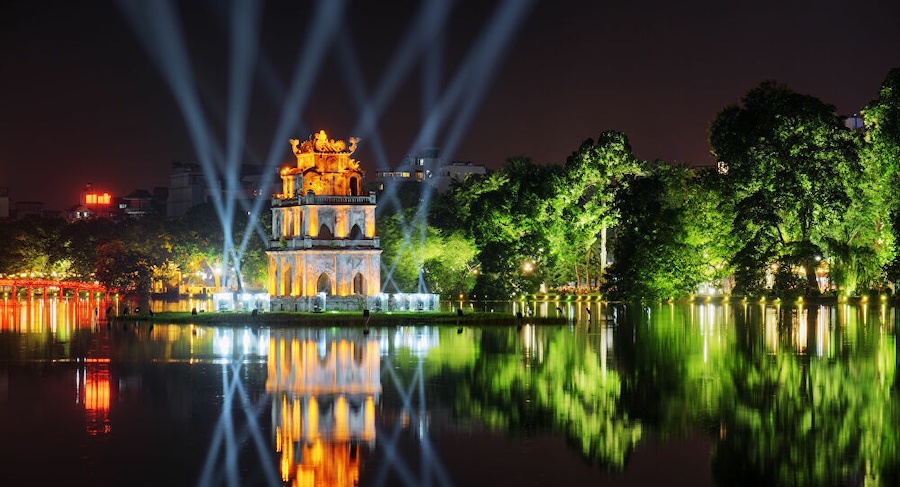Though Indochine Francais was officially formed in 1887, the Treaty of Saigon started the French colonization in Vietnam from 1862 to 1945. During 83 years of its colonization, the French imposed significant political and cultural changes on Vietnamese society. Vietnam fell under French influence in many aspects of its culture, including architecture, cuisine, religion, fashion, and art. Even after the first and second Indochina wars, those influences remained and were known as the Indochine style.

The Indochine style, often in a fusion of Vietnamese and French styles, is most visible in architecture and can still be seen throughout much of the country, especially in the capital Hanoi. Once known as the Paris of the Orient, Hanoi is typified by French colonial villas in different European styles, tree-lined boulevards, and many other fascinating buildings in its French Quarter.

Located right in the city center, the neoclassical Hanoi Opera House is one of the most striking examples of the Indochine style. Modeled on the famous Palais Garnier in Paris, the building is considered to be one of the architectural landmarks of the city. The splendid interiors of this grand structure are sparked with Italian marble floors, copper chandeliers, French doors, and murals on the ceiling.

Nearby is the Sofitel Legend Metropole Hanoi Hotel, which is truly another example of French colonial style. Since its opening in 1901, it has been one of the most luxurious hotels in Asia and the hotel of choice for visiting heads of state, movie stars, and authors like Graham Greene, Charlie Chaplin, Joan Baez, Brad Pitt, and Angelina Jolie. The hotel is a perfect evocation of the colonial style, beginning with the cyclo and the vintage Citroën parked on the shaded sidewalk. The lobby features precious wood, prints, chinoiserie furniture, and white orchids. Rooms boast elegant entryways, dark wood floors, and slowly revolving ceiling fans.

The Presidential Palace in Hanoi, the house of the former French Governor-General of Indochina, was completed in 1906. This grand building was constructed by Auguste Henri Vildieu, the official architect for French Indochina. This yellow Italian Renaissance-style palace stands among green mango trees growing on the ground, it is today used for official state visits and important guests.
In central Vietnam, the architecture of the former imperial capital city of Hue also features a good mixture of the Nguyen dynasty, Buddhist culture, and French styles. In the 1890s, a new district was built across the Perfume River from the ancient imperial city. Notable French structures include the La Residence Hue Hotel & Spa, an Art Deco masterpiece that was built on the riverbank as the guest house for the French Colonial-Governor of Indochina, and the Le Cercle Sportif, a riverside Art Modern building that served as a tennis and social club for the colonial elite.

In southern Vietnam, Ho Chi Minh City, which is still widely referred to as Saigon, has undergone a dramatic transformation in recent years, with many modern apartments replacing French colonial buildings. However, several French structures have survived the urban renewal around them, such as the Saigon Opera House which was completed in 1897, and the Notre Dame Cathedral built in the late 1800s. Another landmark is the intricate City Hall which was built in 1908 and is still used as a government building, and the Saigon Central Post Office, which was designed by Gustave Eiffel and, with its vaulted roof and arched windows, is reminiscent of the grand railway stations of Europe. Among the newly built structures in Saigon, there is one that pays respect to the French colonial style: The Park Hyatt Saigon. Though it was built in 2005 when the city was changing itself to adapt the economic growth, it fits right in with other historic colonial buildings.

During the colonization, food culture has also infused the local cuisine. Many ingredients used in Vietnamese cooking are still called by their French names, such as “cà rốt” (carrot), “sa lát”- salade (salad), “pa-tê”- pâté, and “xúc xích”- saucisse (sausage). Among them, “bánh mì” (Vietnamese sandwich), and “cà phê” (coffee) are the most noticeable foods, that have been well adopted by Vietnamese people.
Banh mi is an airy French baguette with a thin crunchy crust that Vietnamese stuff in with cornucopia of roast chicken or pork, homemade pork-liver pâté, headcheese, cured ham, pickled daikon radish, carrot, a generous sprinkling of cilantro leaves, slices of cucumber and chili pepper, a few dashes of mixed fish sauce, and a light spread of mayonnaise.
Coffee was introduced by the French in the 1880s, it is now an essential part of daily life with coffee streets in almost every big city. Ca Phe Sua Da is the name of the classic Vietnamese condensed milk iced coffee, which is made with Vietnamese-grown dark roast Robusta coffee beans that are brewed in a silver drip filter pot, sweetened with condensed milk, and then poured over ice cubes. Hanoi’s famous egg coffee was also influenced by French drinks.

Christianity was also introduced to Vietnam by the French and Portuguese. Alexandre de Rhodes, a priest from France, managed to convert some 6000 people between 1627 and 1630. Today, about 8% of the Vietnamese population are Roman Catholic, and French-built churches are seen in many areas in Vietnam. An alphabet for the Vietnamese language, using the Latin script with added diacritic marks, was also developed by Alexandre de Rhodes and other Jesuit missionaries. This writing system continues to be used today as the Vietnamese official language.



